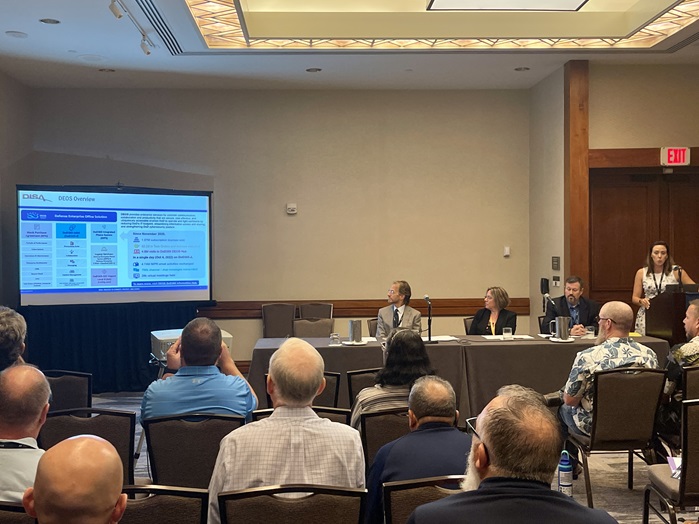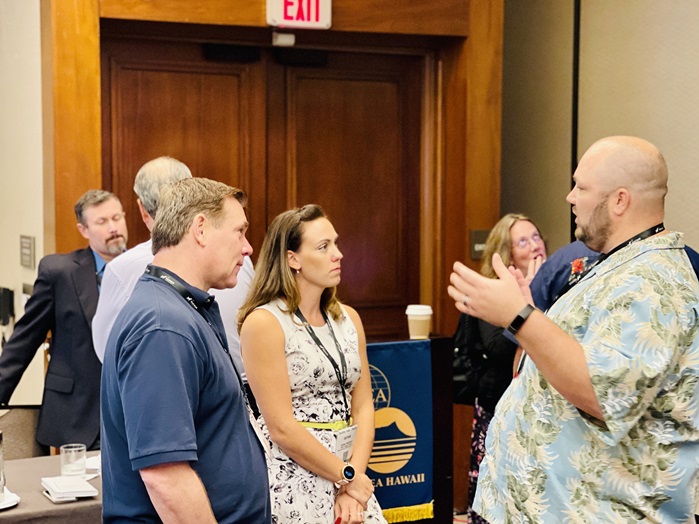Anticipating the warfighter’s future cyber needs
DISA provides critical updates for warfighting capabilities at TechNet Pacific 2022
by Dillon McConnell
Office of Strategic Communication and Public Affairs
November 21, 2022

(DISA photo by Dillon Mcconnell)
Early this month, Defense Information Systems Agency experts presented at the AFCEA TechNet Indo-Pacific conference in Honolulu, Hawaii, which focused on Pacific Rim defense issues.
Fully packed theater sessions included military, government and industry attendees who received information about a variety of defense cyber topics ranging from DISA’s development forecast, zero trust, hybrid cloud strategies and high frequency radio communications.
TechNet Indo-Pacific featured speakers and discussions about the area’s challenges and how industry and government can collaborate on ongoing efforts across the Pacific Rim, due to the large military presence and continued regional threat vectors.
DISA is steadfast in deterring adversarial threats and foreign state actors looking to harm the Department of Defense’s information technology and cyber infrastructure and capabilities.
Command and Control
With increasing pressures and persistent state actors within the Pacific such as Russia, North Korea and the People’s Republic of China, command and control, or C2, remains DISA’s number one priority. This means DISA is not only modernizing warfighter support systems and unified capabilities to improve C2, but also working to increase information sharing and maximize its support to combatant commands across the world.
“DISA PAC is here to support United States Indo-Pacific Command and our military partners’ cyber and C2 missions in theater, however we can,”
said Marine Corps Col. Jared Voneida, commander for DISA’s Pacific Command. “We are a force multiplier and will offer our assistance and services to ensure that we are deterring threats across the region,”
But as cyber threats continue to grow in the Pacific, Voneida reinforced that DISA will remain a constant presence to support not only our military services, but those of DISA’s coalition partners, to ensure it is meeting the needs for the “future fight.”
“The warfighter’s future fight will be driven by information exchange requirements: Who are you talking to? When are you talking to them? What do you want to tell them?” explained Voneida. “[DISA] can help come up with the solution on how you can pass along that information. This is key, especially in bandwidth constrained or denied access environments … to ensure that we are getting critical C2 applications to where they need to go.”
For more than 20 years, DISA has been a cornerstone for the defense C2 community; providing C2 systems necessary for warfighters to accomplish their no-fail missions.
These longstanding C2 applications, developed and delivered by DISA, are extensively used worldwide by tens of thousands of warfighters and users from the White House, military services, combatant commands and defense agencies. As DISA continues to update and modernize these systems, their integration with Joint All Domain Command and Control, or JADC2, will be critical in helping arm commanders and warfighters with the right information and data to take appropriate and decisive action in near real time.
“DISA has current C2 capabilities that can enable JADC2,”
said Jason Martin, director for DISA’s Digital Capabilities and Security Center. “We know that we enable other capabilities across the department, we do that today, all of which are fundamental principles for JADC2 and essential to the framework to work. DISA has a roadmap for how each of our capabilities can contribute.”
This will be even more crucial as the department moves towards a data-centric network.
Zero trust
Thunderdome, DISA’s first version of a zero trust security model, will help shift the DOD from its current network-centric approach to one that is centered on the protection of the data. To this end, DISA is working to improve security and resiliency of DOD’s networks while bettering the user experience.
“Thunderdome is our initial implementation of a zero trust architecture, focused on zero trust network access,”
said Alan Rosner, program manager for the Thunderdome Program. “Our goal is to reduce redundant and complex cybersecurity equipment, which will greatly improve the orchestration of the network, and figure out how we can better provide DOD’s Information Network to our customers.”
Since the fight is fought within the classified network, there has been a need for modernization. Rosner explained that part of the Thunderdome pilot encompasses a prototype on the classified side, or SIPRNet, which is in line with the department’s SIPRNet modernization efforts. Thunderdome hopes to create a better user experience both on the unclassified and classified networks by streamlining network traffic, reducing latency, and improving adversarial threat detection.
Throughout the sessions DISA focused on what the agency is doing to provide best value for the Department of Defense, the military services and warfighters. To achieve this, last year DISA Director Air Force Lt. Gen. Robert J. Skinner directed the agency to conduct Strategic Program Assessments, or SPAs, which are thorough analyses of DISA’s capabilities and services to determine which are the greatest worth to DOD. SPAs help ensure that DISA is meeting the ever-changing needs of the warfighter and is providing the department with the best services and the greatest user experience. Redundant services and those whose usage levels are not sustainable have, and will be, consolidated or terminated so that DISA can develop and deliver modernized capabilities at the velocity of action.
Looking ahead

(DISA photo by Dillon Mcconnell)
DISA is undergoing a plan to modernize and improve products and services to better the warfighter user experience on both the unclassified and classified networks. Carissa Landymore, DISA’s Defense Enterprise Office Solution program manager, said one highly anticipated service that DISA will be delivering is DOD365-Secret, or SEC. While still in development and testing, DOD365-SEDC will be a cloud-based set of Microsoft office applications on SIPRNet. Currently, SIRPNet lacks classified communication and collaboration capabilities to meet warfighter and DOD mission needs. DISA’s DOD365-SEC will bring the classified workspace into the 21st century to operate ahead of the adversary by allowing users to communicate and collaborate virtually through Microsoft Teams and other applications.
Additionally, Landymore gave updates to TechNet Pacific attendees about DISA’s development and addition of new capabilities and services designed to better the end user’s experience. Critical to these operations includes DISA’s Defense Enterprise Office Solution’s delivery of the DOD365 Integrated Phone System, a virtual desk phone through Microsoft Teams, which will allow military services and defense agencies to reduce their telephony footprint and realize significant cost savings.
Throughout TechNet Pacific, DISA’s experts highlighted the agency’s commitment toward driving technological change across the DOD – while remaining resolute in improving cybersecurity. DISA continues to lean on industry partners to help provide solutions to tackle some of the hardest cyber challenges the DOD faces.
Learn More
Follow us on Twitter, LinkedIn and Facebook to learn more about how DISA is strengthening the Nation and Warfighter communications.
DISA: Trusted to Connect, Protect and Serve
Learn more